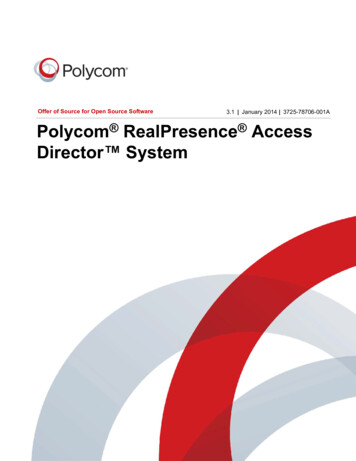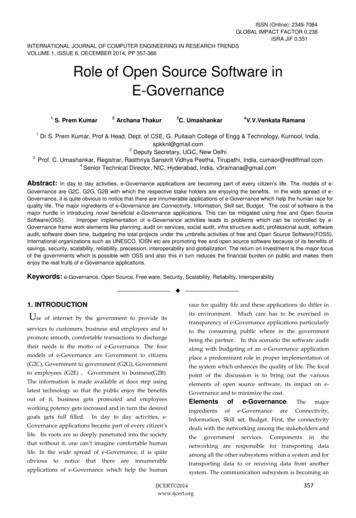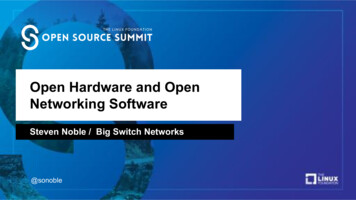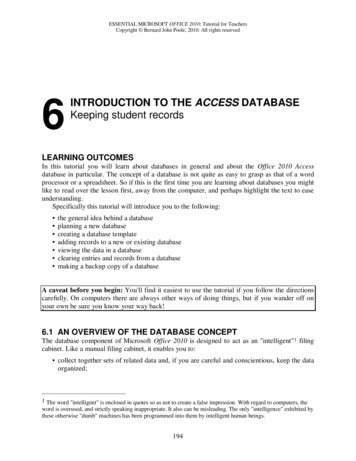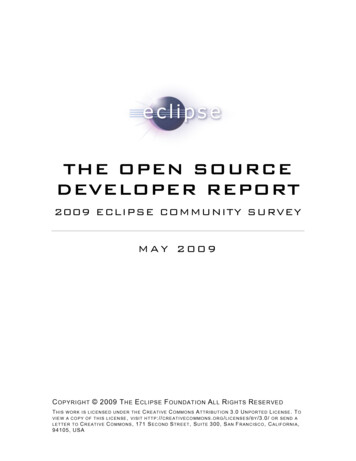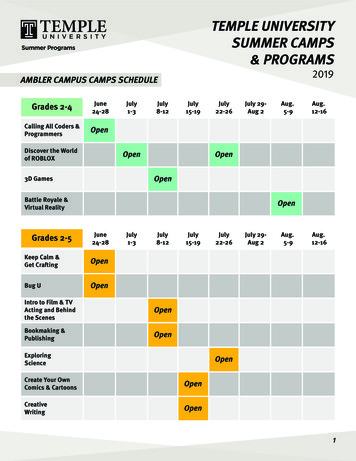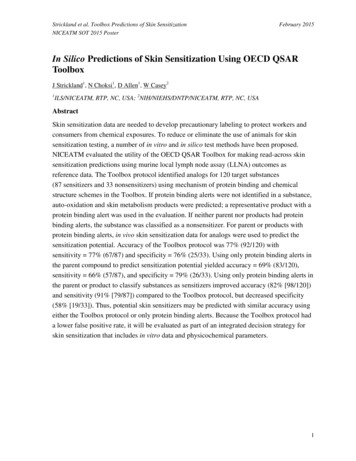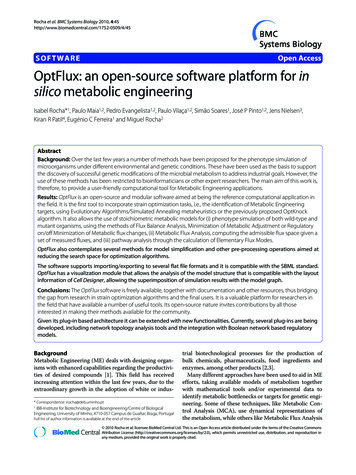
Transcription
Rocha et al. BMC Systems Biology 2010, n AccessSOFTWAREOptFlux: an open-source software platform for insilico metabolic engineeringSoftwareIsabel Rocha*1, Paulo Maia1,2, Pedro Evangelista1,2, Paulo Vilaça1,2, Simão Soares1, José P Pinto1,2, Jens Nielsen3,Kiran R Patil4, Eugénio C Ferreira1 and Miguel Rocha2AbstractBackground: Over the last few years a number of methods have been proposed for the phenotype simulation ofmicroorganisms under different environmental and genetic conditions. These have been used as the basis to supportthe discovery of successful genetic modifications of the microbial metabolism to address industrial goals. However, theuse of these methods has been restricted to bioinformaticians or other expert researchers. The main aim of this work is,therefore, to provide a user-friendly computational tool for Metabolic Engineering applications.Results: OptFlux is an open-source and modular software aimed at being the reference computational application inthe field. It is the first tool to incorporate strain optimization tasks, i.e., the identification of Metabolic Engineeringtargets, using Evolutionary Algorithms/Simulated Annealing metaheuristics or the previously proposed OptKnockalgorithm. It also allows the use of stoichiometric metabolic models for (i) phenotype simulation of both wild-type andmutant organisms, using the methods of Flux Balance Analysis, Minimization of Metabolic Adjustment or Regulatoryon/off Minimization of Metabolic flux changes, (ii) Metabolic Flux Analysis, computing the admissible flux space given aset of measured fluxes, and (iii) pathway analysis through the calculation of Elementary Flux Modes.OptFlux also contemplates several methods for model simplification and other pre-processing operations aimed atreducing the search space for optimization algorithms.The software supports importing/exporting to several flat file formats and it is compatible with the SBML standard.OptFlux has a visualization module that allows the analysis of the model structure that is compatible with the layoutinformation of Cell Designer, allowing the superimposition of simulation results with the model graph.Conclusions: The OptFlux software is freely available, together with documentation and other resources, thus bridgingthe gap from research in strain optimization algorithms and the final users. It is a valuable platform for researchers inthe field that have available a number of useful tools. Its open-source nature invites contributions by all thoseinterested in making their methods available for the community.Given its plug-in based architecture it can be extended with new functionalities. Currently, several plug-ins are beingdeveloped, including network topology analysis tools and the integration with Boolean network based regulatorymodels.BackgroundMetabolic Engineering (ME) deals with designing organisms with enhanced capabilities regarding the productivities of desired compounds [1]. This field has receivedincreasing attention within the last few years, due to theextraordinary growth in the adoption of white or indus* Correspondence: irocha@deb.uminho.pt1IBB-Institute for Biotechnology and Bioengineering/Centre of BiologicalEngineering, University of Minho, 4710-057 Campus de Gualtar, Braga, PortugalFull list of author information is available at the end of the articletrial biotechnological processes for the production ofbulk chemicals, pharmaceuticals, food ingredients andenzymes, among other products [2,3].Many different approaches have been used to aid in MEefforts, taking available models of metabolism togetherwith mathematical tools and/or experimental data toidentify metabolic bottlenecks or targets for genetic engineering. Some of these techniques, like Metabolic Control Analysis (MCA), use dynamical representations ofthe metabolism, while others like Metabolic Flux Analysis 2010 Rocha et al; licensee BioMed Central Ltd. This is an Open Access article distributed under the terms of the Creative CommonsBioMed Central Attribution License (http://creativecommons.org/licenses/by/2.0), which permits unrestricted use, distribution, and reproduction inany medium, provided the original work is properly cited.
Rocha et al. BMC Systems Biology 2010, A) or Flux Balance Analysis (FBA) apply steady-statestoichiometric models to study the phenotype of microorganisms, under different environmental and geneticconditions (a thorough description of these techniquescan be found for example in [1]).Also based on stoichiometric networks, the field ofPathway Analysis characterizes the complete space ofadmissible flux distributions, allowing the analysis of themeaningful routes by dissecting them into basic functional units named Elementary Flux Modes (EFMs) [4].Therefore, EFMs analysis is a valuable tool in ME but itsapplication is limited by two issues: the problem of calculating EFMs in large networks is computationally veryhard and, even if this process is successful, their analysisis also difficult, given their high cardinality.Although many nice examples have been described onsuccessful modifications of the microbial metabolismusing the above-mentioned techniques (e.g. some of theexamples described in [5]), very few methodologies existthat effectively aid in the rational design of microbialstrains by, for example, pinpointing the genetic modifications that can lead to enhanced production capabilities,by using available genome-scale mathematical models (e.g. [6]). This limitation is related with the fact thatgenome-scale models account for a significant number ofgenes and reactions, and therefore any resulting MEproblem will require quite robust optimization tools.One of the first approaches to tackle this class of problems was the OptKnock algorithm [7], where Mixed Integer Linear Programming (MILP) is used to identify anoptimum set of knockouts under a metabolic steady-stateapproximation. An alternative solution was proposed bythe OptGene algorithm [8,9], that considers the application of Evolutionary Algorithms (EAs) and SimulatedAnnealing (SA) in this scenario. These meta-heuristicmethods are capable of providing near-optimal solutionswithin a reasonable computation time, being also quiteflexible regarding the objective function that can be optimized (e.g. they are able to deal well with non linear functions).However, the application of such optimization algorithms and even the use of genome-scale metabolic models for pure simulation has been limited to the developersof the techniques or experienced bioinformaticians, sincea platform that provides a user friendly interface to perform such tasks is not yet available. The computation ofEFMs is also enabled by some applications, but there isthe need of proper tools to conduct the required analysisto fully take advantage on the results in an ME perspective.Furthermore, the solutions obtained by using thosemethods or the strategies inferred by model simulationsneed to be validated before the implementation in thelaboratory, because of model uncertainties. This valida-Page 2 of 12tion is hampered by the complexity of the model itselfand of the solutions obtained. In fact, if an ME target ismost often not obvious, the analysis of a possible solutiongiven by an algorithm is definitely difficult to interpretand validate.While, in 2001, the need for mathematical and computational tools to aid in ME efforts was already identifiedby James Bailey [10], by the time of writing of this textvery few user-friendly software tools were still available.Besides some tools developed a few years ago, such asFluxAnalyzer [11] and MetaFluxNet [12], recently theCellNetAnalyzer [13] (the successor of FluxAnalyzer), theCOBRA toolbox [14] and the Systems Biology ResearchTool (SBRT) [15] have been launched. COBRA and CellNetAnalyzer are software packages running over theMATLAB environment. Both allow performing manytasks useful in ME like FBA, flux variability analysis andthe simulation of gene deletion mutants. CellNetAnalyzeris, however, a more comprehensive software tool thatallows to analyse metabolic, regulatory and signallingnetworks. COBRA was built mainly to perform flux andpathway analysis, either with or without experimentaldata. The SBRT consists of an open-source platformimplemented in the Java language and allows performingmost of these operations, and also includes other capabilities such as data analysis tools. However, the SBRT andCOBRA present an important limitation, since they donot provide a user-friendly interface.Two other applications have been recently proposed:YANAsquare [16] and SNA [17]. The first is an application developed in Java with a user interface, while the latter is a Mathematica package. Both these tools areessentially focused in calculating the EFMs of a networkand using those to perform the analysis of its metaboliccapabilities. However, they are quite limited from a MEperspective (although SNA also allows calculating FBA).Furthermore, none of the aforementioned tools allowsto perform strain optimization functions, i.e. they do notper se include algorithms for the identification of potential ME targets. Additionally, there is also a need forappropriate model visualization tools associated withsimulation software.Given the huge potential impact of the growing numberof genome-scale metabolic models [18], the availability ofopen source simulation and strain optimization softwarewould be a key to their further development and exploitation. At present, experimenters from both academia andindustry find it very difficult to use genome-scale stoichiometric models for simulation and optimization purposes.Towards the purpose of changing this scenario, wehereby introduce OptFlux, a software tool that aims to bethe reference platform for the ME community. The mainfeatures of this tool are the following:
Rocha et al. BMC Systems Biology 2010, 4:45http://www.biomedcentral.com/1752-0509/4/45- Open-source - it allows all users to use the tool freelyand invites the contribution of other researchers;- User-friendly - facilitates its use by users with no/littlebackground in modelling/informatics;- Modular - facilitates the addition of specific featuresby computer scientists, given its plug-in based architecture;- Compatible with standards -compatibility with theSystems Biology Markup Language (SBML) [19] and thelayout information of Cell Designer [20].At the current version (2.0), the software accommodates several tools and algorithms that have been developed for the manipulation of metabolic models: methods for phenotype simulation, such as FBA,Minimization of Metabolic Adjustment (MOMA)[21] and Regulatory on/off minimization of metabolicflux changes (ROOM) [22]; methods for MFA, allowing the introduction by theuser of values for experimentally measured fluxes andcalculating the effects on the flux space; Elementary modes analysis, allowing the calculationof the set of EFMs for the network and its visualization and further analysis; strain optimization algorithms: OptKnock, EAs andSA. a suitable model visualization tool to facilitate theinterpretation of results.To the best of our knowledge, this is the first tool thatallows performing strain optimization in a user-friendlyinterface and the first effort to create a community-basedand community-oriented software for ME with suchcharacteristics.The main concepts used in the development of OptFluxand its main functionalities are presented in the next sections.ImplementationOptFlux is fully implemented in the Java language, whichis being increasingly used by the scientific community.BioVisualizer is based on the Jung Java library [23]. Theonly non-Java parts consisted on the GNU Linear Programming Kit (GLPK) [24] used to execute all linear programming and MILP computations and the LibSBML[25] used to handle files in the SBML format.To ensure modularity, OptFlux is implemented in sucha way that new features and services are easily plugged in.It is entirely built on top of AIBench [26], a softwaredevelopment framework that was born as a collaborativeproject between the authors and researchers from theUniversity of Vigo in Spain.Building applications over AIBench brings importantadvantages to both the developers and the users, given itsdesign principles and architecture. The applicationsPage 3 of 12incorporate the three types of well defined objectsdescribed before: operations, datatypes and datatypeviews, following the MVC (model-view-controller) designpattern. This leads to units of work with high coherencethat can easily be combined and reused. Furthermore, itis plug-in based: applications are developed adding components, called plug-ins, each containing a set of AIBenchobjects. This allows reusing and integrating functionalityof past and future developments based on AIBench.ResultsOptFlux's main capabilities can be grouped into distinctfunctional areas that will be described in detail below.Figure 1 shows the high-level organization of OptFlux,including the main operations that can be performedwithin the software. In Figure 2, a schematic representation of the main functionalities of OptFlux is given, showing the typical fluxes of information. Starting with astoichiometric metabolic model that can be loaded in different formats (SBML, Metatool or flat files), the user canperform simulations under different environmental andgenetic conditions (using either FBA, MOMA orROOM), investigate ME targets for improving the production of desired compounds, analyze the flux spacegiven a set of measured fluxes with MFA methods or perform the computation and further analysis of the EFMs.The full description of the currently implemented features is provided in the application's set of How To's available at the project's website. Furthermore, a Beginner'stutorial is available for helping first-time users.Model handlingRegarding model handling, OptFlux makes available anumber of operations to visualize, import and export stoichiometric metabolic models, including reactions,metabolites, equations and, if available, gene-reactionassociations. It allows the loading of models either fromflat text files (containing the lists of reactions, metabolites, the stoichiometric matrix and gene-reaction associations), from text files following the Metatool [27] formator from files complying with the SBML standard. Thecompatibility with SBML allows the use of models storedin public databases, e. g. BioModels [28] or the BiGGdatabase [29] or built using other software tools, e.g. CellDesigner [20]. The process of loading a model is facilitated by the development of a wizard that encompassesseveral steps, where the user can choose from a numberof options related to the format of the input files.External metabolites and biomass formation reactionsare automatically identified from the input files based onan explicit definition, compartment information or bypatterns in the names. This information can then be validated or edited by the user.
Rocha et al. BMC Systems Biology 2010, e 4 of 12Figure 1 Functional modules of the OptFlux application.SimulationThe Simulation area encompasses the metabolic phenotype simulation methods implemented in OptFlux, i.e.the algorithms that calculate the values for the fluxes overthe whole set of reactions in the model. It is possible toperform simulations of the wild-type (see note 1) andmutant strains. In the first case, the original model is considered with no additional constraints, while in the lattera number of user selected reactions (or genes if the modelincludes gene-reaction associations) are removed fromthe original model before simulation. The simulationresults include, besides the flux values, net conversionsand shadow price information and are placed in OptFlux's clipboard area, becoming easily accessible for further analysis or future operations.One other feature available is the ability to define specific Environmental Conditions. These are created byselecting a set of drain reactions (reactions that stand forthe intake and secretion of external metabolites) and,then, imposing constraints over the values of their fluxes.As an illustrative example, this allows the definition ofaerobic or anaerobic conditions by changing the limits inthe oxygen uptake reaction. Environmental conditionscan be used in both wild-type and mutant simulations.OptFlux has three available methods for conducting thesimulations: FBA (see for example [30]), MOMA [21] orROOM [22]. The first method uses a Linear Programming (LP) formulation to calculate the values of all thefluxes over the reactions and can be used to simulateeither wild-type or mutant strains. To reach the FBAsolution, by default the flux over the reaction that represents biomass formation is the one being maximized,since this has proven to be a good representation of thenatural behaviour of microorganisms in many circumstances [31], but it is possible to perform simulations bymaximizing or minimizing any flux of the model.MOMA and ROOM are appropriate only for the simulation of mutants, since they calculate the minimum distance solution or the solution with minimum number ofchanges, respectively, for the mutant strain relative to theoriginal "wild-type" solution (i. e. obtained with FBA).MOMA uses a Quadratic Programming formulationwhile ROOM is implemented based both on the originalMILP formulation and an LP relaxation of the originalMILP problem (proposed by the original authors) [22].OptFlux also includes some features for Flux VariabilityAnalysis (FVA). Currently, there are two tools available,allowing to: Calculate the maximum possible value of a selectedflux, for a range of fixed values for the biomass flux(typically varying from 0 to 100% of its value in thewild-type strain); Calculate the maximum and minimum limits for allfluxes in the model, given a constraint imposed by auser-defined minimum biomass value. If this value iszero, this is equivalent to compute the tight bounds ofthe fluxes for all reactions.
Rocha et al. BMC Systems Biology 2010, e 5 of 12Figure 2 Main functionalities and fluxes of information in the OptFlux application.The calculation of the fluxes can also be performedadding experimental data, used to constrain the originalmetabolic model, using MFA methods. Depending on thenumber of measured fluxes, the resulting system can beclassified as underdetermined, determined or over-determined. Determined and over-determined systems aresolved using the methods described in [1]. Concerningunderdetermined systems, there are no unique solutionsfor the unknown flux set. Thus, an FBA problem is formulated and solved as described previously. Furthermore,it is possible to compute the tight bounds respecting themeasured constraints.OptimizationThe strain optimization area provides the users withinterfaces to identify sets of reaction deletions (or genedeletions if gene-reaction associations are available) thatmaximize a given objective function related with adesired industrial objective. The ultimate purpose of theimplemented algorithms is to identify genetic modifications that force the microorganism to produce a particu-lar metabolite, while still obeying the physiological aim ofmaximizing biomass production.The OptKnock algorithm [7] and two meta-heuristicoptimization methods, EAs and SA [8], are currentlyavailable. The first was implemented following the original formulation [7] and also the methods described in[32]. It should be noted that in our implementation onlyfreely available solvers can be used, while in previouswork the commercial CPLEX solver has been used. Also,from our experiments, running OptKnock in genomescale models (such as the one from our case study) isquite demanding and can lead to situations of numericalinstability in the solver.On the other hand, the metaheuristics are configuredwith some default parameters, using set-based representations that can search through fixed-size or variable-sizesolutions. In the first case, the user specifies the numberof allowed reaction/gene deletions, while in the latter theoptimization algorithm also performs the automatic discovery of the optimum value for that variable. Both meth-
Rocha et al. BMC Systems Biology 2010, e 6 of 12ods were implemented by the authors and the results inseveral case studies have been previously presented [8].At present, OptFlux allows to maximize two differentobjective functions: Yield and Biomass-Product CoupledYield. In the first case, the yield on the desired compoundis targeted but a minimum biomass level is imposed,while the second searches for mutants that are likely toexhibit higher productivities, since biomass production isalso included in the objective [8].The high number of variables typically involved in agenome-scale metabolic model makes the optimizationtask computationally hard. Thus, it is important to beable to simplify the models without compromising theiraccuracy and information content. In this context, twoalternatives are available: to simplify the model in termsof its structure (these operations are valid in every scenario, i.e. considering all environmental conditions) andalso to simplify the model using simulation, calculatingthe limits of the reaction fluxes using a simulationmethod such as FBA.In the structural simplification context, two operationsare available: finding zero valued reactions, i.e. reactionsthat are mathematically constrained to have the value ofzero for the corresponding flux and, also, finding equivalent reactions, i.e. reactions that are constrained to havethe same flux value and, therefore, can be replaced by asingle reaction.Regarding the simulation-based simplification operations, the original bounds can be replaced by the calculated limits. Also, this method can be used to identifyzero valued fluxes (reactions for which both new lowerand upper limits of the fluxes are zero). It is important tonotice that this method is dependent on the environmental conditions defined.Another feature provided is an automatic method forthe discovery of essential reactions, i.e. reactions thatwhen disabled, make the organism non-viable. If genereaction associations are included in the model, a similaroperation can be defined for the discovery of essentialgenes. In both cases, an organism is found to be viable ifthe value for the biomass flux is significantly larger than 0(i.e. larger than 5% of the wild type value). The essentialgenes or reactions are not used as targets for optimization, since they would unnecessarily increase the numberof decision variables and therefore the size of the searchspace.OptFlux allows the graphical visualization of the pathways through BioVisualizer, a visualization plug-in thatwas developed to represent metabolic networks asgraphs, with a number of distinct node types (e.g. metabolites, enzymes, reactions) and connections.If a Cell Designer SBML file is loaded as the modelsource, automatically it will be used by BioVisualizer inthe visualization operations, using the layout built previously in Cell Designer. Also, if the original model isloaded from flat files or normal SBML, BioVisualizer canwork if a Cell Designer SBML file is available, typicallyrepresenting only a subset of the whole model (e.g. apathway) with compatible names for the reactions.One of the major features of this tool is the ability toassociate numerical values to the different types of nodesand edges. This allows the visualization of the metabolicnetwork overlapped by the values of the fluxes obtainedin a given simulation. Moreover, the flux values can beexported to Cell Designer if the model was created from aCell Designer SBML file.Elementary flux modes analysisUser interactionOptflux also allows state-of-the-art EFM calculation provided by the EFMTool [33] that implements one of themost efficient algorithms available. Moreover, it providesa simple user interface that allows an intuitive filtering ofthe results that match given patterns.OptFlux development has taken as a first premise to builda tool aimed at biotechnology researchers and not atcomputational or bioinformatics experts. Thus, the primary goal in the development process was to providegood usability, valuing the simplicity and intuitiveness ofthe tool.After the computation of the EFMs, the net conversionassociated with each EFM is calculated (only unique conversions are maintained). Furthermore, for each net conversion, the greatest common divisor is calculated toimprove the reading of the conversion equation. To do so,all the coefficients have to be integers and, therefore, theEFM calculation is limited to using big integer arithmetic.In the filtering step, EFMs can be selected based on thepresence/absence of external metabolites in the net conversions. Moreover, they can also be sorted by yield,assuming that an input and an output metabolite are provided.The user can browse through the filtered conversions ina table that presents the conversion equation, yields andprovides access to the set of related EFMs. This vieweralso allows row sorting based on any column criteria. Thevisualization of the EFMs is presented in a column-wisetable, where each column corresponds to an EFM andeach line to a reaction of the model. Each EFM, i.e. its fluxvalues, can be exported to Cell Designer, if the model wascreated from a Cell Designer SBML file. For each reactionin the EFM, the line in the Cell Designer layout is represented with a thickness that is proportional to the valueof the flux.Visualization
Rocha et al. BMC Systems Biology 2010, 4:45http://www.biomedcentral.com/1752-0509/4/45The user interaction is based on three main concepts,used throughout the application: Datatypes: represent the distinct types of objectsholding the relevant data to the application (such asmodels, simulation or optimization results, etc). Eachtype can have multiple instances (objects) within theapplication. Views: represent different ways to visualize the contents of data objects. Each datatype can have one ormore methods to visualize its instances. Operations: represent the software functionalities oravailable actions. When an operation is called, itsinterface is launched and the input data objects areselected. After being triggered, an operation typicallychanges or creates an instance of the output datatype.Based on these concepts, a user-friendly Graphical UserInterface (GUI) was developed. The original layout of thecomponents can be observed in the screenshots presented in Figure 3.The clipboard on the left (Figure 3a) keeps all dataobjects created within the application, in a logical hierarchy, grouped by their datatypes. The root of this tree isPage 7 of 12the Project datatype that keeps all objects related to agiven metabolic model and the analysis performed withit.The components of a project are graphically shown inthe form of explicit hierarchical containers, namely: The metabolic model, including the sets of metabolites (internal and external), the set of reactions withtheir flux bounds and stoichiometry, the steady stateequations and, when available, the encoding genesand the gene-reaction association rules; A set of simplified models that are the result of modelsimplification operations; Sets of simulation and optimization results, includingalso MFA and flux variability analysis results; Other optional objects grouped in the project elements list, including: a model graph for visualization tobe used by BioVisualizer, environmental conditions, listsof essential genes/reactions, results from EFMs computation, among others.When an object in the clipboard is double-clicked, theviews corresponding to its datatype will be launched onthe right side of the working area (if more than one viewFigure 3 Screenshots of OptFlux: a) Clipboard containing the main datatypes; b) view of model graphical representation; c) one of the availableviews of the stoichiometric model; d) mutant simulation operation; e) Optimization with EA's; f) wizard for starting a new project.
Rocha et al. BMC Systems Biology 2010, 4:45http://www.biomedcentral.com/1752-0509/4/45is available, those are accessible in different tabs). Examples of two views of a metabolic model are shown in Figures 3b and 3c.All the available operations are easily accessible, eitherthrough the menu in the top or by right clicking the itemin the clipboard area, an action that displays all operations that work over that type of argument. Snapshots ofsimulation and optimization operations are shown in Figures 3d and 3e.To make the usage of the software easier, a wizard wasdeveloped for creating a new model (Figure 3f). This wizard is visible in the toolbar and is also available in themenu. It encompasses a number of steps that allow theuser to define the setup for each operation in a straightforward way.All operations are, at the maximum possible level,default-oriented, thus hiding behind scenes their complexity (e.g. definition of non-obvious parameters). Nevertheless, they allow more advanced users to fine-tunethe parameters available to a given operation.Usage example: succinate production with E. coliTo illustrate the main features of the application, a casestudy is shown here that considers the microorganismEscherichia coli and where the aim is to produce succinicacid, with glucose as the carbon source. The genomescale model used in the simulations was developed by[34], considering the whole E. coli metabolic networkwith a total of 1075 fluxes and 761 metabolites. A simplerexample is given in the Tutorial (available at the website)where a small model of Sacharomyces cerevisiae is used.Succinic acid is one of the key intermediates in cellularmetabolism
Results: OptFlux is an open-source and modular software aimed at being the reference computational application in the field. It is the first tool to incorporate strain optimization tasks, i.e., the identification of Metabolic Engineering targets, using Evolutionary Algorithms/Simulated Annealing metaheuristics or the previously proposed OptKnock


